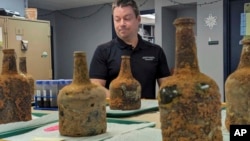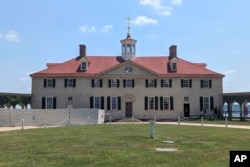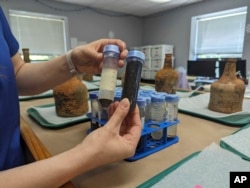Researchers have made what they call a “spectacular” finding at the Mount Vernon home of America’s first president: almost 30 bottles of preserved fruit.
The bottles of cherries and berries were preserved in storage areas in the cellar of George Washington’s home near the Potomac River.
Researchers discovered the fruits during an archaeological dig connected to a restoration project.
Jason Boroughs is Mount Vernon’s head archaeologist. He said the discovery of so much perfectly preserved food from more than 250 years ago is almost unequaled.
“Finding… fresh fruit, 250 years later, is pretty spectacular,” Boroughs told the Associated Press. Whole pieces of fruit, recognizable as cherries, were found in some of the bottles. Other bottles held what appear to be gooseberries or currants, though testing is underway to confirm that.
Mount Vernon is partnering with the U.S. Department of Agriculture (USDA), which is doing DNA testing on the fruit. The USDA is also examining more than 50 cherry pits recovered from the bottles to see if any of them can be planted.
Benjamin Gutierrez, a USDA plant scientist, said the chances of using a cherry pit to grow a tree are low. Seeds preserve best when they are dry, and most of the pits found at Mount Vernon were wet. A couple of pits tested at first were not able to be used as seeds.
Still, Gutierrez said the bottles are a remarkable find. In addition to DNA testing, he said chemical testing may be able to show if spices were used to preserve the fruits.
Records at Mount Vernon show that George and Martha Washington enjoyed cherries, at least when mixed with the alcoholic drink known as brandy. Martha Washington’s recipe for a “cherry bounce” drink survives. And Washington wrote that he took some cherry bounce with him on a trip across the Alleghenies in 1784.
These cherries, though, were most likely bottled to be eaten as food, Boroughs said.
The quality of the preservation suggests skilled work. The kitchen was overseen by an enslaved woman named Doll, who came to Mount Vernon in 1758 with Martha Washington.
Boroughs said the slaves were probably responsible for the preservation process and described the work as “highly skilled.” He added that if the work was poorly done it “wouldn’t have survived this way.”
The bottles were found only because Mount Vernon is doing a $40 million restoration project on the house. The work is expected to be finished by the nation’s 250th birthday in 2026.
Boroughs said the archaeological dig started because the ground was going to be affected during structural repairs to the house. “We didn’t expect to find all this,” he said.
Researchers know the bottles date to before 1775 because that is when a building project on the house led to the area being covered over with a brick floor.
Mount Vernon announced back in April, at the start of its archaeological work, that it had found two bottles.
As the dig continued, the number increased to 35 in six different storage pits. Six of the bottles were broken, with the other 29 in good condition. Twelve held cherries, 16 held the other berries believed to be currants and gooseberries, and one larger bottle held both cherries and other berries.
Boroughs believes they have now uncovered all the cherries and berries that survived.
“There is a lot of information that we’re excited to get from these bottles,” he said.
I’m Andrew Smith.
Matthew Barakat reported on this story for the Associated Press. John Russell adapted it for VOA Learning English.
________________________________________________
Words in The Story
spectacular – adj. very impressive
preserve – v. to prevent food from decaying; to keep in good condition
cellar – n. the part of a building that is below ground
restore – v. to return something to good condition (by repairing, cleaning, etc. )
pit – n. the hard middle part of a fruit
recipe – n. a set of instructions for making food or drink











Forum